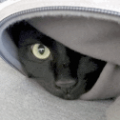A tip for the KiwiSDR GPS antenna installation.
One item that I found to be really useful, that I have not seen in the installation or use documentation, is to ensure that the GPS puck is on a decent ground plane.
The only area where I can put my GPS puck antenna is on a ground floor windowsill between my house and the house next door. There is ~4 meters to the opposite wall, and 9 meters of wall height on each wall. This means that I do not have good visibility to the sky, and I had issues with GPS reception. Often I would only have one or two satellites in view. I decided to go and do something about that, and try a few things before investing in another GPS antenna or having to make an extension coax cable. I located a spare steel biscuit tin left over from last Christmas, and I stuck the GPS antenna via the inbuilt magnet onto the top of the tin lid, and taped the lid to the windowsill.
This addition of this ground plane was enough to give me enough SNR to consistently see and track three to six satellites, and ensuring a consistent clock and location, even with my limited sky visibility.
It might be worth adding to the installation webpage to try putting the GPS antenna on top of a metal plate, if GPS signals are proving hard to receive.
The only area where I can put my GPS puck antenna is on a ground floor windowsill between my house and the house next door. There is ~4 meters to the opposite wall, and 9 meters of wall height on each wall. This means that I do not have good visibility to the sky, and I had issues with GPS reception. Often I would only have one or two satellites in view. I decided to go and do something about that, and try a few things before investing in another GPS antenna or having to make an extension coax cable. I located a spare steel biscuit tin left over from last Christmas, and I stuck the GPS antenna via the inbuilt magnet onto the top of the tin lid, and taped the lid to the windowsill.
This addition of this ground plane was enough to give me enough SNR to consistently see and track three to six satellites, and ensuring a consistent clock and location, even with my limited sky visibility.
It might be worth adding to the installation webpage to try putting the GPS antenna on top of a metal plate, if GPS signals are proving hard to receive.

Comments
My time to first fix on the Kiwi is always abysmal, but that is entirely due to poor antenna location. If I extend the coax to put the antenna another ~5m away in the general vicinity of my NTP server's antenna, then I'll have most of a sky to play with. Plans for later in the week I think.
I've now got a solid and consistent track 12 / use 12 instead of the 5/4 I was getting before tin lid addition, and better than the 3/1 I was getting at the beginning. Now also getting a consistent 30 fix/second.
The Kalman filter assumes that the KiwiSDR GPS antenna does not move. Turning off the Kalman filter while moving in a car should help.